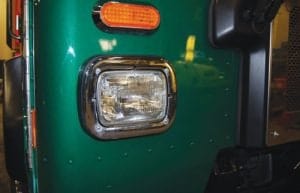Broken or cloudy headlights reduce driver visibility and may limit the ability of other drivers from seeing you. During pre-trip and post-trip inspections, drivers should examine headlights to ensure that they are working and providing adequate light. Cloudy and damaged headlights should be repaired, restored or replaced as needed.
By Will Flower
Headlights are critical to truck safety especially at night and during poor weather conditions. Not only do headlights help drivers see, but they also enhance vehicle visibility so that other drivers can see and stay clear of the truck.
Many headlights are constructed with polycarbonate plastic that is both lightweight and strong. Most plastic headlights are coated with a UV layer over the lens to protect it from scratches and chips. Over time, the lens may oxidize and appear cloudy or discolored. The damage to the lens is more intense when the headlight is exposed to chemical cleaners, sunlight and heat.
Additionally, road debris such dirt, rocks and other particles will strike the lens and create tiny chips and nicks in the lens. After many miles, the degradation of the lens can significantly limit the ability of the headlight to illuminate the pathway in front of the vehicle.

Replacing or Restoring Headlights
By restoring the clarity of the lens, drivers will dramatically improve their visibility. There are many methods for restoring cloudy lights. Some include chemical treatment of the lens while other treatments involve sanding the lens with ultra-fine grit sandpaper. A mechanic can determine the best restoration option for the fleet. If the restoration does not work, the lens or the entire headlight assembly may need to be replaced.
Check All Lights
Headlights are not the only lenses that can be affected. Large vehicles, such as waste collection vehicles, roll off trucks and transfer trailers are required to carry additional lighting and reflective packages beyond those required on passenger vehicles. The specific requirements can vary according to the regulations in force where the vehicle is registered. Fleet managers, safety managers and commercial drivers should be aware of the lighting requirements for the vehicles in operation. All lights should all be checked to ensure that they are working properly and producing sufficient light for the intended purpose:
• Turn Signals—Used to indicate a change of lane, change of direction or turn, the turn signals are required to flash on and off at a steady rate between 60 and 120 blinks per minute.
• Tail Lights—Provide drivers behind the vehicle with a visual aid to identify the rear end of a vehicle. Tail lights are red and wired so that they illuminate whenever the parking lights or headlights are on.
• Brake Lights—Used to indicate when the driver has applied brakes. Brake lights may be combined with the taillights and will project a red light that is brighter than the taillights. Passenger cars and pickup trucks manufactured after 1986 will have a center brake light that is mounted above the vehicle’s left and right brake lights.
• Work Lights—Many collection vehicles have work lights that allow workers to see in and around the loading area on the truck. Work lights should be pointed toward the ground and should not impair the vision of drivers of other vehicles. Work lights should be clean and bright to allow workers to see the ground and the surrounding area to avoid trip hazards such as curbs, potholes and uneven terrain.
• Backup Lights—Provide light at the rear of the vehicle when the vehicle’s transmission is placed in reverse. The backup light must be a white light.
• License Plate Lights—Designed to illuminate the surface of the license plate on the vehicle. Only the rear license plate is required to be illuminated. The license plate light should turn on any time the parking lights or headlights are on.
• Marker and Clearance Lights—Trucks that are more that 80 inches wide must be equipped with marker lights that consist of three amber lights on the front of the cab and three red lights on the rear of the vehicle, as high as practicable. Large vehicles must also be equipped with left and right amber side marker lights and reflectors.
Make it a Habit
Good visibility and being highly visible is critical for safe operations of a waste collection vehicle. The law for headlight use in many states is that if your windshield wipers need to be on, you should also turn on your headlights, taillights and marker lights. Even if headlight use is not required when raining, it is a good practice to use headlights to enhance visibility. Again, drivers should make it a habit to check all lights, including the condition of the lens, during every pre-trip and post-trip inspection to ensure all lights are properly working and to help reduce the driver’s chances of being involved in a crash. | WA
Next month’s Safety Brief will focus on hurricane preparedness and business resumption.
Will Flower is the Vice President of Corporate and Public Affairs at Winters Bros. Waste Systems. Will has 36 years of experience in the area of solid waste management and environmental protection. He has held operational and executive leadership positions at the Director’s Office of the Illinois Environmental Protection Agency, Waste Management, Inc., Republic Services. Inc. and Green Stream Recycling.
Share your safety tip. Submit your suggestions to
Will Flower at [email protected].
